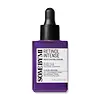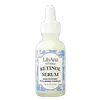What's inside
What's inside
 Key Ingredients
Key Ingredients

 Benefits
Benefits

 Concerns
Concerns

 Ingredients Side-by-side
Ingredients Side-by-side

Water
Skin ConditioningCyclohexasiloxane
EmollientDicaprylyl Carbonate
EmollientGlycerin
HumectantMethylpropanediol
Solvent1,2-Hexanediol
Skin ConditioningNiacinamide
SmoothingHydrogenated Poly(C6-14 Olefin)
EmollientPanthenol
Skin ConditioningTocopheryl Acetate
AntioxidantPiper Methysticum Leaf/Root/Stem Extract
Skin ConditioningCentella Asiatica Extract
CleansingPanax Ginseng Berry Extract
Skin ConditioningGlycyrrhiza Glabra Root Extract
BleachingFicus Carica Fruit Extract
HumectantCentella Asiatica Leaf Extract
Skin ConditioningCentella Asiatica Root Extract
Skin ConditioningMelaleuca Alternifolia Leaf Extract
PerfumingArtemisia Capillaris Extract
Eclipta Prostrata Extract
Skin ConditioningMelia Azadirachta Leaf Extract
Skin ConditioningElaeis Guineensis Oil
EmollientHydrogenated Lecithin
EmulsifyingGlyceryl Stearate
EmollientBakuchiol
AntimicrobialPalmitic Acid
EmollientSodium Polyacrylate
AbsorbentStearic Acid
CleansingXanthan Gum
EmulsifyingRetinol 0.1%
Skin ConditioningAcrylates/C10-30 Alkyl Acrylate Crosspolymer
Emulsion StabilisingButylene Glycol
HumectantDipotassium Glycyrrhizate
HumectantAdenosine
Skin ConditioningTromethamine
BufferingPolyquaternium-51
Skin ConditioningBeta-Glucan
Skin ConditioningCetyl Alcohol
EmollientBHT
AntioxidantCollagen
MoisturisingMyristic Acid
CleansingBHA
AntioxidantLeuconostoc/Radish Root Ferment Filtrate
AntimicrobialTocopherol
AntioxidantBifida Ferment Lysate
Skin ConditioningCeramide NP
Skin ConditioningSaccharomyces Ferment
Skin ConditioningRetinal
Skin ConditioningAsiaticoside
AntioxidantGlyceryl Polymethacrylate
Madecassoside
AntioxidantPropylene Glycol
HumectantPolyglyceryl-10 Oleate
Skin ConditioningGlycolipids
Skin ConditioningGlycine Soja Peptide
Skin ConditioningResveratrol
AntioxidantSucrose Distearate
EmollientAsiatic Acid
Skin ConditioningMadecassic Acid
Skin ConditioningPalmitoyl Tripeptide-1
Skin ConditioningMoringa Oleifera Seed Oil
EmollientPEG-100 Stearate
Polysorbate 20
EmulsifyingParfum
MaskingEthylhexylglycerin
Skin ConditioningWater, Cyclohexasiloxane, Dicaprylyl Carbonate, Glycerin, Methylpropanediol, 1,2-Hexanediol, Niacinamide, Hydrogenated Poly(C6-14 Olefin), Panthenol, Tocopheryl Acetate, Piper Methysticum Leaf/Root/Stem Extract, Centella Asiatica Extract, Panax Ginseng Berry Extract, Glycyrrhiza Glabra Root Extract, Ficus Carica Fruit Extract, Centella Asiatica Leaf Extract, Centella Asiatica Root Extract, Melaleuca Alternifolia Leaf Extract, Artemisia Capillaris Extract, Eclipta Prostrata Extract, Melia Azadirachta Leaf Extract, Elaeis Guineensis Oil, Hydrogenated Lecithin, Glyceryl Stearate, Bakuchiol, Palmitic Acid, Sodium Polyacrylate, Stearic Acid, Xanthan Gum, Retinol 0.1%, Acrylates/C10-30 Alkyl Acrylate Crosspolymer, Butylene Glycol, Dipotassium Glycyrrhizate, Adenosine, Tromethamine, Polyquaternium-51, Beta-Glucan, Cetyl Alcohol, BHT, Collagen, Myristic Acid, BHA, Leuconostoc/Radish Root Ferment Filtrate, Tocopherol, Bifida Ferment Lysate, Ceramide NP, Saccharomyces Ferment, Retinal, Asiaticoside, Glyceryl Polymethacrylate, Madecassoside, Propylene Glycol, Polyglyceryl-10 Oleate, Glycolipids, Glycine Soja Peptide, Resveratrol, Sucrose Distearate, Asiatic Acid, Madecassic Acid, Palmitoyl Tripeptide-1, Moringa Oleifera Seed Oil, PEG-100 Stearate, Polysorbate 20, Parfum, Ethylhexylglycerin
Aloe Barbadensis Leaf Juice
Skin ConditioningGlycerin
HumectantHamamelis Virginiana Water
AstringentSimmondsia Chinensis Seed Oil
EmollientHelianthus Annuus Seed Oil
EmollientJojoba Esters
EmollientSambucus Nigra Fruit Extract
AstringentArachidyl Alcohol
EmollientTribehenin
EmollientTocopheryl Acetate
AntioxidantGlyceryl Stearate
EmollientNiacinamide
SmoothingCopernicia Cerifera Wax
Behenyl Alcohol
EmollientArachidyl Glucoside
EmulsifyingHyaluronic Acid
HumectantAcacia Senegal Gum
MaskingXanthan Gum
EmulsifyingRetinol
Skin ConditioningChamomilla Recutita Flower Extract
MaskingCucumis Sativus Fruit Extract
EmollientAllantoin
Skin ConditioningAloe Barbadensis Leaf Juice, Glycerin, Hamamelis Virginiana Water, Simmondsia Chinensis Seed Oil, Helianthus Annuus Seed Oil, Jojoba Esters, Sambucus Nigra Fruit Extract, Arachidyl Alcohol, Tribehenin, Tocopheryl Acetate, Glyceryl Stearate, Niacinamide, Copernicia Cerifera Wax, Behenyl Alcohol, Arachidyl Glucoside, Hyaluronic Acid, Acacia Senegal Gum, Xanthan Gum, Retinol, Chamomilla Recutita Flower Extract, Cucumis Sativus Fruit Extract, Allantoin
 Reviews
Reviews

Ingredients Explained
These ingredients are found in both products.
Ingredients higher up in an ingredient list are typically present in a larger amount.
Glycerin is already naturally found in your skin. It helps moisturize and protect your skin.
A study from 2016 found glycerin to be more effective as a humectant than AHAs and hyaluronic acid.
As a humectant, it helps the skin stay hydrated by pulling moisture to your skin. The low molecular weight of glycerin allows it to pull moisture into the deeper layers of your skin.
Hydrated skin improves your skin barrier; Your skin barrier helps protect against irritants and bacteria.
Glycerin has also been found to have antimicrobial and antiviral properties. Due to these properties, glycerin is often used in wound and burn treatments.
In cosmetics, glycerin is usually derived from plants such as soybean or palm. However, it can also be sourced from animals, such as tallow or animal fat.
This ingredient is organic, colorless, odorless, and non-toxic.
Glycerin is the name for this ingredient in American English. British English uses Glycerol/Glycerine.
Learn more about GlycerinGlyceryl Stearate is a mix of glycerin and stearic acid.
It is used to stabilize the mixing of water and oil ingredients. By preventing these ingredients from separating, it can help elongate shelf life. It can also help thicken the product's texture.
As an emollient, it helps soften skin and supports barrier-replenishing ingredients.
In cosmetics, Glyceryl Stearate is often made from vegetable oils or synthetically produced.
This ingredient may not be fungal-acne safe
Fun fact: The human body also creates Glyceryl Stearate naturally.
Learn more about Glyceryl StearateNiacinamide is a multitasking form of vitamin B3 that strengthens the skin barrier, reduces pores and dark spots, regulates oil, and improves signs of aging.
And the best part? It's gentle and well-tolerated by most skin types, including sensitive and reactive skin.
You might have heard of "niacin flush", or the reddening of skin that causes itchiness. Niacinamide has not been found to cause this.
In very rare cases, some individuals may not be able to tolerate niacinamide at all or experience an allergic reaction to it.
If you are experiencing flaking, irritation, and dryness with this ingredient, be sure to double check all your products as this ingredient can be found in all categories of skincare.
When incorporating niacinamide into your routine, look out for concentration amounts. Typically, 5% niacinamide provides benefits such as fading dark spots. However, if you have sensitive skin, it is better to begin with a smaller concentration.
When you apply niacinamide to your skin, your body converts it into nicotinamide adenine dinucleotide (NAD). NAD is an essential coenzyme that is already found in your cells as "fuel" and powers countless biological processes.
In your skin, NAD helps repair cell damage, produce new healthy cells, support collagen production, strengthen the skin barrier, and fight environmental stressors (like UV and pollution).
Our natural NAD levels start to decline with age, leading to slower skin repair, visible aging, and a weaker skin barrier. By providing your skin niacinamide, you're recharging your skin's NAD levels. This leads to stronger, healthier, and younger looking skin.
Another name for vitamin B3 is nicotinamide. This vitamin is water-soluble and our bodies don't store it. We obtain Vitamin B3 from either food or skincare. Meat, fish, wheat, yeast, and leafy greens contain vitamin B3.
The type of niacinamide used in skincare is synthetically created.
Learn more about NiacinamideRetinol is a gold-standard ingredient for anti-aging. It is a form of Vitamin A and belongs to the class of retinoids that also includes tretinoin.
Why is retinol famous?
It has the most scientific studies backing up its skin benefits out of all the non-prescription ingredients.
Retinol is proven to:
This is why retinol is effective at removing wrinkles, fading dark spots, treating acne, and reducing the appearance of pores.
Studies show retinol is less effective when exposed to UV. Be sure to look for appropriate packaging to keep your retinol potent (similar to Vitamin C).
Using retinol or any retinoids will increase sun-sensitivity in the first few months. Though studies show retinoids increase your skin's natural SPF with continuous use, it is best to always wear sunscreen and sun-protection.
We recommend speaking with a medical professional about using this ingredient during pregnancy.
Retinol may cause irritation in some people, so be sure to patch test. Experts recommend 'ramping up' retinol use: start using this ingredient once a week and work up to using it daily.
Read about Tretinoin
Learn more about RetinolTocopheryl Acetate is AKA Vitamin E. It is an antioxidant and protects your skin from free radicals. Free radicals damage the skin by breaking down collagen.
One study found using Tocopheryl Acetate with Vitamin C decreased the number of sunburned cells.
Tocopheryl Acetate is commonly found in both skincare and dietary supplements.
Learn more about Tocopheryl AcetateXanthan gum is used as a stabilizer and thickener within cosmetic products. It helps give products a sticky, thick feeling - preventing them from being too runny.
On the technical side of things, xanthan gum is a polysaccharide - a combination consisting of multiple sugar molecules bonded together.
Xanthan gum is a pretty common and great ingredient. It is a natural, non-toxic, non-irritating ingredient that is also commonly used in food products.
Learn more about Xanthan Gum